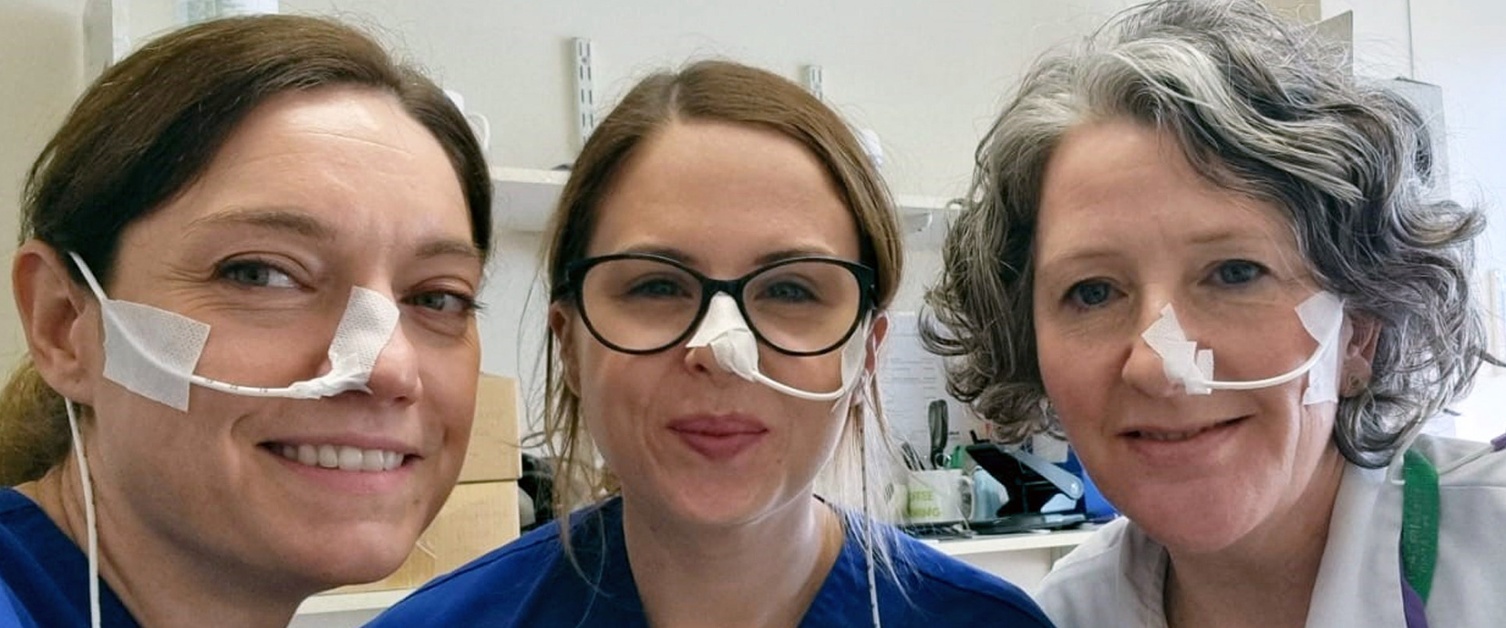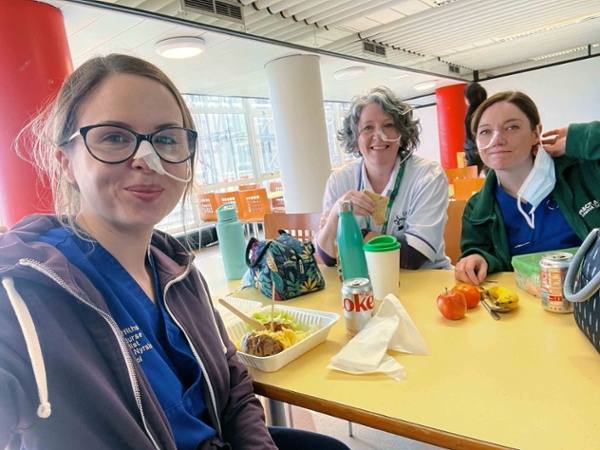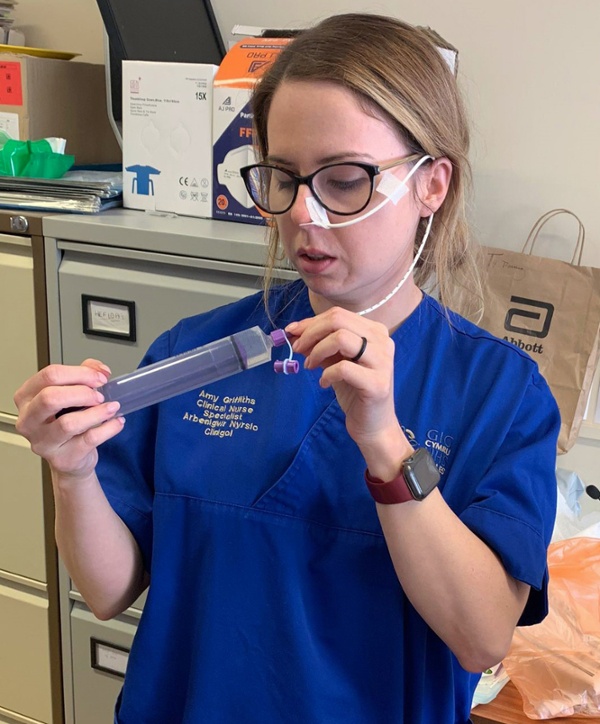Staff have nasal feeding tubes inserted to find out how it feels for their patients

Dedicated staff went to unusual lengths to find out how their patients feel – by having a feeding tube inserted from their nose down to their stomach.
People with conditions ranging from cancer to stroke often need what is known as a nasogastric tube because of problems eating or swallowing.
Main photo above shows, left to right, Llynos Webster, Amy Malyn and Sharon Davies
The tube allows nutrition to be delivered in liquid form, either for the patient’s entire calorific intake or as a supplement.
Macmillan clinical nurse specialist Llynos Webster, nutrition nurse specialist Amy Malyn and Macmillan specialist dietitian Sharon Davies.
They were thinking about what they could do as part of Enteral (tube) Feeding Week, which took place earlier this year.
Amy explained: “We had some leftover equipment that had gone out of date so we thought – why not try these tubes ourselves?
“Just to experience what life is like for patients, who have a tube inserted and then are expected to go home and just carry on as normal.
“It was Llynos who had the idea. I wasn’t sure what I thought about it at first, but then the three of us just went for it.”
Llynos said they thought it was important they should experience first-hand what their own patients experienced.
 “We put these tubes in patients all the time. And we often say that, once the tube is in you can’t feel it, it’s no big deal. But we wanted to find out for ourselves,” she said.
“We put these tubes in patients all the time. And we often say that, once the tube is in you can’t feel it, it’s no big deal. But we wanted to find out for ourselves,” she said.
“Then we started thinking about how long did we do it for. Just putting the tube in and taking it out after half an hour didn’t feel long enough.
“We also wanted to find out what it was like to sleep with a tube in, and do basic tasks like eating a meal orally.”
Right: The three carried on working as normal, and ate meals, once the tubes were in place
Amy inserted the tube for Llynos, who in turn inserted Amy and Sharon’s tubes. As Sharon underwent a nasal endoscopy some years previously, she had an inkling of what to expect.
Even so, she said, she found it helpful to close her eyes as Llynos approached her with the tube.
“You’re not seeing the tube coming towards you and you’re not apprehensive straight away. It helped calm me,” said Sharon
“The part of it going into the nose was what I was expecting it to feel. For me it was as the tube went down further, through my oesophagus, that started to feel different. I hadn’t experienced that before.
“The tube at the back of the throat, that felt different as well. It was just a different experience, and giving you that insight into what it would be like for people who are having this placed.”
But there is more to the procedure that just inserting the tube. Care has to be taken that it is correctly placed into the stomach, and a sample of gastric acid has to be taken to ensure this.
After that, the tube is flushed with water – which both Llynos and Amy described as a strange, unexpected sensation.
“After that we just carried on and worked all day with the tubes in, taking into account that some people do go to work with them in,” said Amy (left).
 “Driving was quite hard work because when you turned your head to look, it was like a pulling in your throat. It’s just all those little things that we had never really thought about when explaining it to patients.”
“Driving was quite hard work because when you turned your head to look, it was like a pulling in your throat. It’s just all those little things that we had never really thought about when explaining it to patients.”
Llynos added: “The family life aspect was really interesting because my youngest daughter didn’t want to come near me.
“My oldest daughter was interested and my husband wanted to know if I was going to sleep with it in.
“So there are all those parts that we don’t think about. We just assume everyone is going to accept it and be fine.”
Amy was the first to remove her tube, around midnight that same day after showering and having tea. Llynos and Sharon kept theirs in overnight but removed them before starting work the following morning.
The three are now planning to write a reflective piece on their experiences, and how it has helped them in terms of their patients.
Sharon said: “I did my own checking of the tube position while I was home, and actually tried to feed through the tube as well, just to have a sense of, how awkward is this? How dextrous do people need to be?
“I slept with it overnight. Just to get that idea of having the tube in, how it would affect my sleep, how it would affect the way I moved in bed. I was thinking about practical things that might be useful for our patients.
“There are pros and cons to any treatment. With informed consent, I feel I’m more aware of what I’m suggesting to people and why, and talking about some of the advantages and disadvantages with more confidence.”
Llynos added: “It wasn't a pleasant experience. But our patients have these tubes in for weeks, sometimes multiple insertions as well, as they can fall out. So it has made me a lot more aware of things like that.”
Amy agreed, saying: “It really opened our eyes. I’m glad we did it.”
Rydym yn croesawu gohebiaeth a galwadau ffôn yn y Gymraeg neu'r Saesneg. Atebir gohebiaeth Gymraeg yn y Gymraeg, ac ni fydd hyn yn arwain at oedi. Mae’r dudalen hon ar gael yn Gymraeg drwy bwyso’r botwm ar y dde ar frig y dudalen.
We welcome correspondence and telephone calls in Welsh or English. Welsh language correspondence will be replied to in Welsh, and this will not lead to a delay. This page is available in Welsh by clicking ‘Cymraeg’ at the top right of this page.